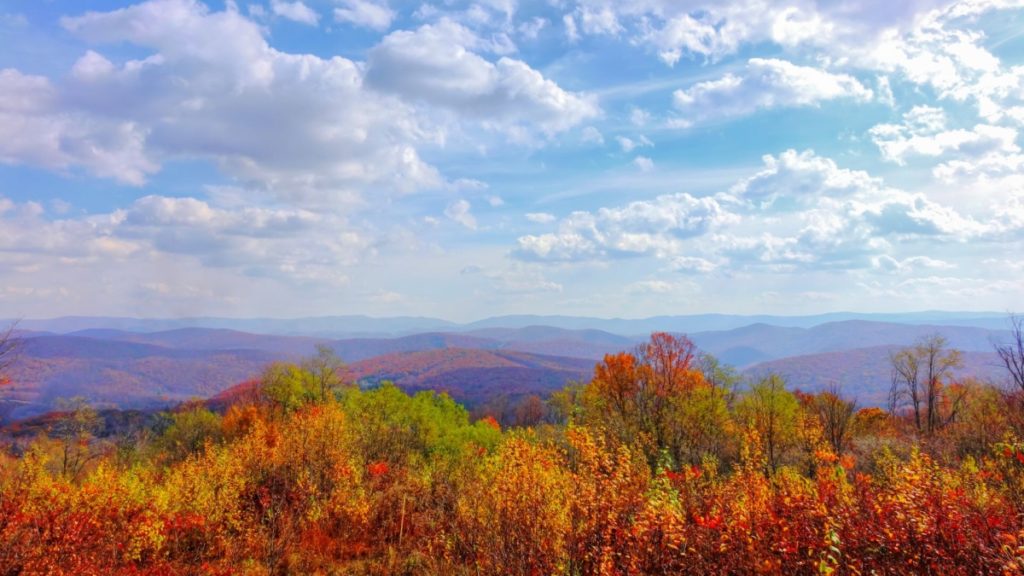
Flowers of the southeast can vary from one region to the next, but many live throughout much of the region and beyond. The southeast region covers and area North to Tennessee and Virginia, South to Florida and to eastern Texas. There can be many temperature extremes in the winter months and heat and humidity for the rest of the year. Y
You are fortunate, however to have a large group of native trees and shrubs to choose from to create a cool, shady garden and even a woodland habitat that attracts birds, butterflies and mammals. There are many native flowers of the southeast region you can choose from. Much depends on your landscape and of course what you want and your personal taste. After all it is your yard and you want something eye pleasing for you, not some cookie cutter design.
If you want a woodland garden, you will want to have levels of plantings. Large trees for birds to fly around in and create shade. Shrubs and small trees like dogwood to plant in the understory and of course, all sorts of native flowers that attract the birds, hummingbirds, butterflies and other critters your may desire.
I can give you a sample of what to look for in native plants of the southeast, but check out other regions like flowers of the northeast and Prairies as many of these cross regions and it would become boring to read if every region mentioned the same plants.
Many wildflowers like Jack-in-the-pulpit, Trillium and Lobelia do indeed cover the northeast and the southeast regions and are wonderful for the woodland and shade gardens. The key to growing perennials is to see how zone hardy they are and to understand what growing zone you are in.
The southeast region covers zones 6A (The ground can freeze) to a sub-tropical zone 10B and zone 11 in the Florida Keys. You will also want to consider the plants needs.
- Are they sun loving or do they require shade?
- Is the plant you are looking for require dry soil or moist conditions?
- What about soil pH and the plants needs?
Consider all of these things and more before you go out and buy out a garden canter and plant them where ever you want them. Plan and plant with your trees, shrubs and flowers needs in mind.
Okay, let’s take a look at some native bloomers you may enjoy in your southeast gardens.
Lyreleaf sage, cancerweed (Salvia lyrata)
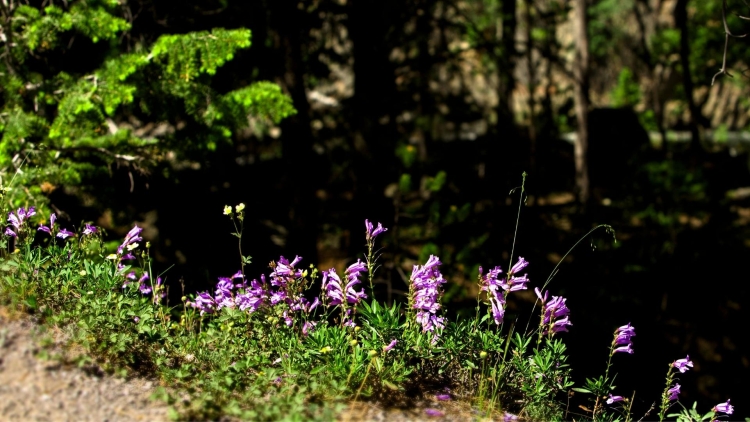
This perennial wildflower forms a basal rosette of elongated leaves that broaden toward the tips. The stalked leaves have irregular margins that usually appear pinnately lobed or cut.
- They may be solid green or blotched with a dark wine-purple along the midrib.
- A 1-2 ft. hairy square stem emerges from this rosette to bear uneven whorls of two-lipped lavender to blue flowers. The shorter upper lip of the tubular 1 in bloom has three lobes; the lower longer lip has two.
- Heaviest flowering is typically during a several-week period between April and June, but the plants may produce a few flowers at almost any time of year, especially if mowing or cutting disrupts the usual bloom period.
Usage
- Lyreleaf sage is an excellent choice for planting along roads, trails, driveways and in low-maintenance multi-species lawns.
- A great catch for pollinators and offers small seeds later on for birds.
- The young leaves have a mild minty flavor and may be used in salads or cooked as a potherb.
- A one time, the plant was believed to be a “cure for cancer”.
- This is a seldom-used, easy-to-grow American native plant that shows great potential.
- Lyreleaf sage is native to the eastern United States. It grows as far north as Connecticut and as far west as Oklahoma.
Lyreleaf sage Information and Facts
- Light: Lyreleaf sage will grow in full sun to light shade, but the foliage color is stronger in brighter light.
- Moisture: Although this flower tolerates both flooding and drought very well, it grows best in moist soil.
- Hardiness: USDA Zones 5 – 10.
Perennial sunflower (Helianthus divaricatus)
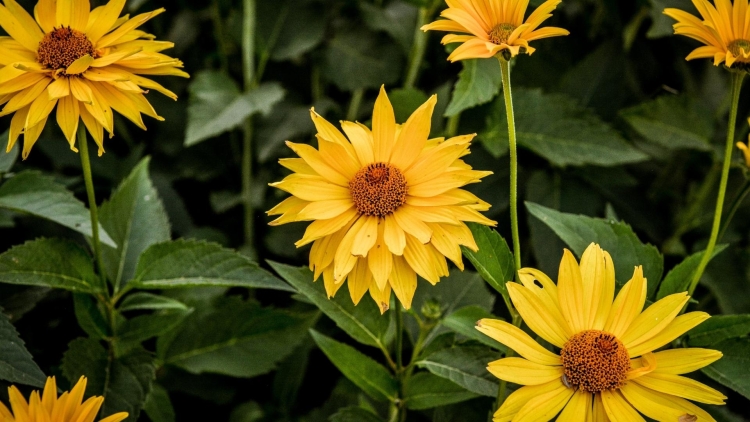
Easily grown in average, dry to medium, well-drained soil in part shade. Tolerant of wide range of soil conditions. Spreads over time by creeping rhizomes to form colonies.
- Divide every 3-4 years to control invasiveness and maintain vigor.
- This sunflower species is a native plant that occurs in open rocky woodlands and thickets.
- Features 2″ wide sunflowers with bright yellow rays and slightly darker yellow center disks atop rigid stems typically growing 2-6′ tall.
- Smooth stems and sessile or short-stalked leaves (to 6″) are the distinguishing characteristics of this species.
- Blooms from mid summer to fall. Good fresh cut flower.
- There are several species and cultivars of Helianthus as well as Heliopsis for your wildlife gardens.
- No serious insect or disease problems. Taller plants may need staking.
Usage
- Sun to partially shaded border, wild or native plant garden, or naturalized planting.
- Attracts birds and butterflies.
Perennial sunflower Information and Facts
- Common Name: sunflower
- Zone: 3 to 8
- Plant Type: Herbaceous perennial
- Native Range: Eastern United States, Oklahoma, Canada
- Height: 2 to 6 feet
- Spread: 1 to 3 feet
- Bloom Time: July – September Bloom Data
- Water: Dry to medium
- Maintenance: Low
Obedient plant (Physostegia virginiana)
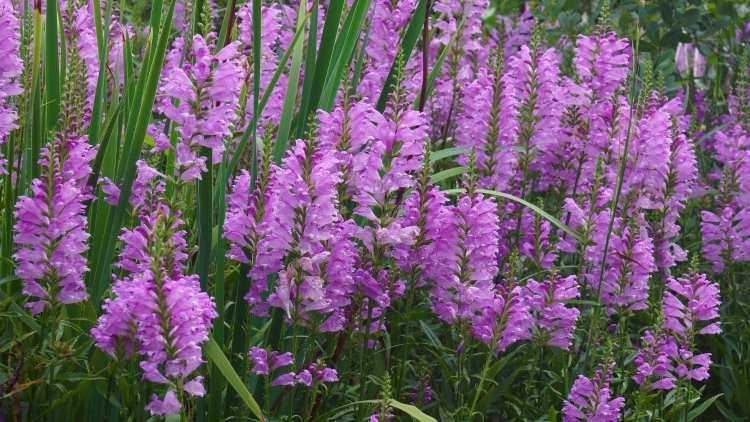
Easily grown in average, medium, well-drained soil in full sun. May need staking, especially if grown in soils with high fertility.
- Prune back in early spring to reduce height and minimize tendency toward floppiness (optional).
- This plant spreads and should be divided every 2-3 years to control growth.
- An erect, clump-forming but rhizomatous native perennial which occurs most often in moist soils on prairies, stream banks, gravel bars and thickets throughout the southeast and beyond.
- It typically grows 2-4′ tall on stiff, square stems and features dense spikes of pinkish or white tubular, two-lipped, snapdragon-like flowers which bloom throughout the summer.
- Obedient plant blooms from bottom to top on each spike. Narrow, lance-shaped, sharp-toothed leaves (to 4″ long).
- Genus members are commonly called obedient plants because each individual bloom will, upon being pushed in any one direction, temporarily remain in the new position as if it were hinged.
- Sometimes also commonly called false dragonhead because they are suggestive of those of dragonhead (Dracocephalum).
- No serious disease or insect problems. Rust is an occasional problem.
- Can be invasive and tends to flop (see General Culture section above).
Usage
- An excellent plant for naturalizing in a wildflower garden, native plant garden, prairie or meadow.
- Provides color and contrast to the perennial border, but invasive spread must be watched. Valued for its late season bloom.
- Bees and butterflies enjoy these flowers. Thick patches offer protection for birds and small mammals.
Obedient plant Information and Facts
- Common Name: obedient plant
- Zone: 3 to 9
- Native Range: Central and southern United States and northeastern Mexico
- Height: 3 to 4 feet
- Spread: 2 to 3 feet
- Bloom Time: June – September Bloom Data
- Bloom Color: Pink, white
- Sun: Full sun
- Maintenance: Medium
Black-eyed-susan (Rudbeckia fulgida)
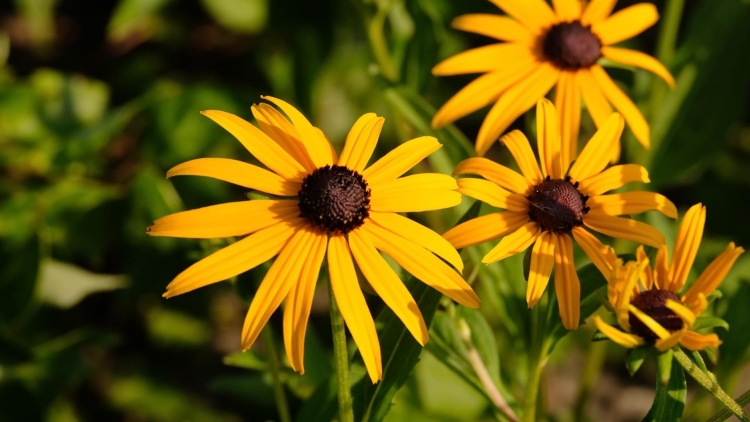
An easily grown flower in average, dry to medium, well-drained soil in full sun. Tolerates hot and humid summers as well as some light shade. Deadhead to prolong bloom. Divide when clumps become overcrowded.
- This species of coneflower is native which occurs in both dry and moist soils in open woods, glades and thickets.
- An upright, rhizomatous, clump-forming, free-blooming coneflower which typically grows to 3′ tall, often forming colonies in the wild.
- Features daisy-like flowers (to 2.5″ across) with yellow rays and brownish-purple center disks.
- Prolific bloom production over a long mid-summer to fall bloom period.
- Oblong to lanceolate, medium green foliage.
- Good cut flower. This species is infrequently sold by nurseries because of the excellent varieties and cultivars available.
- However, new cultivars do not offer the high amounts of pollen and nectar bees and butterflies require.
Usage
- Mass in bold drifts in the perennial border, cottage garden, meadow, native plant garden or naturalized area. Provides excellent bloom and color for the late summer.
- Attracts butterflies and seed heads offer food for several species of birds.
Black-eyed-susan Information and Facts
- Common Name: Black-eyed Susan
- Zone: 3 to 9
- Native Range: Southeastern United States
- Height: 2 to 3 feet
- Spread: 2 to 2.5 feet
- Bloom Time: June – October Bloom Data
- Bloom Color: Orange / yellow
- Sun: Full sun
- Water: Dry to medium
- Maintenance: Low
Fire pink (Silene virginica)
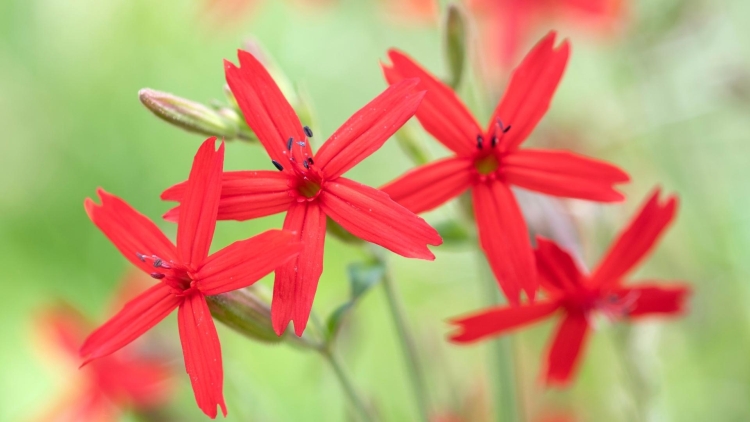
These flowers will grow in average, dry to medium moisture, well-drained soil in full sun to part shade. Prefers part shade and moist, sandy or clay soils. Requires excellent drainage.
- Fire pink is a native wildflower which occurs on rocky wooded slopes, open woods and thickets.
- Small clusters of scarlet red flowers (2″ across) with five notched petals appear in spring atop long, slender stems. Narrow, lance-shaped leaves (to 4″ long).
- Silene is in the same family as Lychnis and Dianthus.
- No serious insect or disease problems.
Usage
- Best in part shade areas of rock gardens, wildflower gardens, native plant gardens, cottage gardens or woodland gardens.
- Attracts hummingbirds.
Fire pink Information and Facts
- Common Name: Fire pink
- Zone: 4 to 8
- Native Range: Eastern North America
- Height: 1 to 1.5 feet
- Spread: 0.75 to 1.5 feet
- Bloom Time: April – June
- Bloom Color: Red
- Sun: Full sun to part shade
- Water: Dry to medium
- Maintenance: Medium
Goat’s beard (Aruncus dioicus)
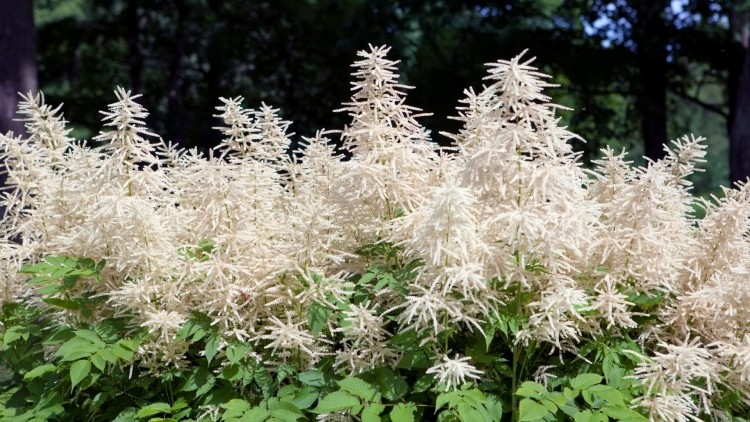
Easily grown in average, medium to wet, well-drained soil in full sun to part shade. Prefers part shade, particularly in the southern part of its growing range (Zones 5-8), and moist, fertile soils.
- This species of goat’s beard is a native plant which occurs in moist woodlands and along bluffs.
- A tall, erect, bushy, clump-forming plant typically growing 4-6′ high which features pinnately compound, dark green foliage and showy, plume-like spikes of tiny, cream colored flowers which rise well above the foliage in early to mid summer, creating a bold effect.
- This rose family member is somewhat similar in appearance to astilbe.
- Dioecious (separate male and female plants) as the species name suggests.
- Plants with male blooms (numerous stamens per flower) produce a showier bloom than plants with female blooms (three pistils per flower).
Usage
- Excellent background plant for shady, moist spots in the border or in a woodland, wild or native plant garden.
- Plant as a specimen or in groups along streams or water gardens.
- Attracts butterflies and other pollinators. Seeds for birds later on.
Goat’s beard Information and Facts
- Common Name: goat’s beard
- Zone: 4 to 8
- Height: 4 to 6 feet
- Spread: 2 to 4 feet
- Bloom Time: April – May, later further North.
- Bloom Color: Cream
- Sun: Full sun to part shade
- Water: Medium to wet
- Maintenance: Low
Greater tickseed (Coreopsis major)
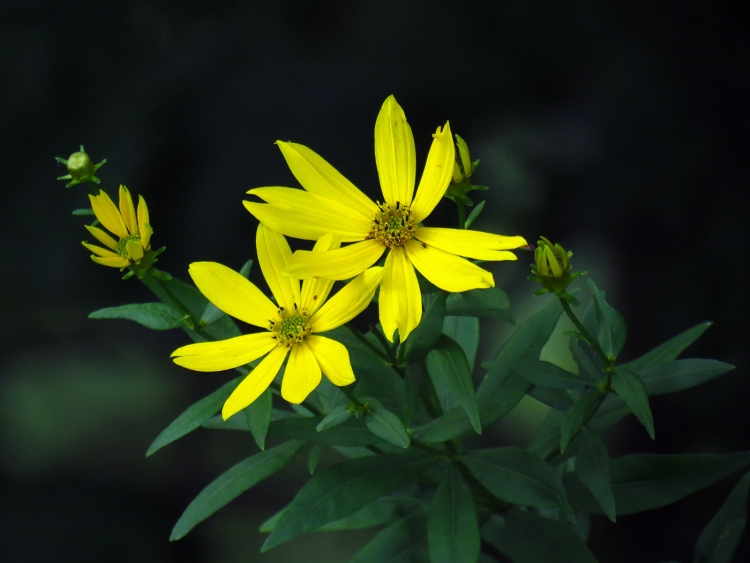
Easily grown in dry to medium moisture, well-drained soil in full sun. Thrives in poor, sandy or rocky soils with good drainage. Tolerant of heat, humidity and drought.
- Prompt deadheading of spent flower stalks encourages additional bloom and prevents any unwanted self-seeding.
- Spreads by stolons and self-seeding and will naturalize over time, but is not considered to be invasive.
- Plants may be cut back hard in summer if foliage sprawls or becomes unkempt. If grown in borders, division may be needed every 2-3 years to maintain robustness.
- This species of coreopsis features large, daisy-like flowers (2″ diameter) with bright yellow rays and yellow (infrequently with a reddish tinge) center disks.
- Untoothed ray flowers are pointed at the tips. Flowers appear in loose clusters from late spring to late summer on erect, branching-at-the-top stems typically rising 2-3′ (less frequently to 4′) tall.
- Opposite, tripartite, sessile lower a mid-stem leaves are paired along the stems giving the appearance of being in whorls of 6 leaves.
- Smaller upper leaves are entire. This plan is commonly called greater tickseed or greater coreopsis in recognition of its large (for coreopsis) flowers and tall stems.
- A somewhat common native to fields, open woodlands, thickets and roadsides in the mid-eastern to southeastern U. S.
- Best naturalized in native gardens, meadows or prairies.
Usage
- Good plant for areas with poor, dry soils. Effective in borders, but self-seeding tendencies must be kept in check.
- There are several species of Coreopsis that would look attractive in your southeast gardens. Be sure to check them out.
Greater tickseed Information and Facts
- Common Name: greater tickseed
- Zone: 5 to 9
- Plant Type: Herbaceous perennial
- Height: 2 to 3 feet
- Spread: 1 to 2 feet
- Bloom Time: June – until it gets to cold to grow
- Bloom Color: Yellow
- Sun: Best in full sun
- Water: Dry to medium
- Maintenance: Low
There are so many flowers of the southeast, I can only scratch the surface, but you get the idea by now.
You have sub-tropical Cannas, native bleeding heart, lupines and much, much more to choose from. Remember, when building your wildlife gardens, think of the local wildlife and what will attract it. Some birds and butterflies prefer open spaces, others enjoy woods edge and others still, enjoy wooded areas or a combination. If you want to attract mammals or toads, look at what they require. Be sure to add some yard art, bird feeders and water to your little corner of the world.
Remember this, it is your yard, do it your way. You have to look at it everyday.
